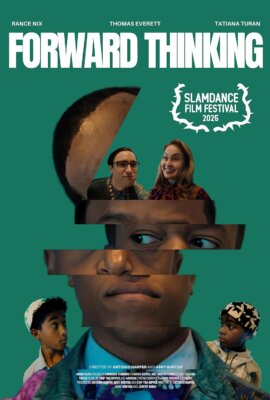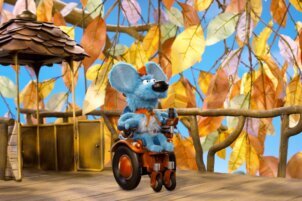 Watching “Forward Thinking” feels like peering into an off-kilter, adjacent reality.
Watching “Forward Thinking” feels like peering into an off-kilter, adjacent reality.
The film opens on a crowded bulletin board, with a tan-colored flyer sitting front and center of the frame. The flyer, written using friendly Comic Sans, is titled “Coffee with Cops,” and offers the chance to meet with officers at a local park “at 2 p.m. this Friday.” It features photos of two smiling white cops – one woman, one man – with speech bubbles hanging over each of their heads. The former’s reads: “We don’t all have domestic assault allegations;” the latter’s “Grab a cup o’ joe with the guy that put away your favorite schmo!”
Cut to James, a black man, looking at the flyer with an expression that shifts between surprised and perplexed.
Viewers soon learn that James is at the Triple K Law Office in the hopes of protecting his likeness. In his attempt to trademark his likeness, James navigates bizarre and intense encounters with several white office workers.
Dwayne Brown, is a paralegal who, almost immediately upon meeting James, declares, “I know what you’re thinking: The name don’t fit the face.” Dwayne continues to make unprompted remarks and attempts to relate and ingratiate himself, with lines such as: “Oh dude, I love that part of town. Yo, the crizzack hits different! It’s on the south side, right?” and performs the “white version” of a rap (as the real lyrics, which include racial slurs, scroll across the screen, sing-along style). Later, seemingly to fill a silence, he states, “You know I, uh, I posted a black square, back when all that shit was going down” (very reminiscent of Get Out’s “By the way, I would have voted for Obama for a third term, if I could. Best President in my lifetime, hands down.”).
Outside of these mostly-one-sided interjections from Dwayne, his hesitation to assist melts away the moment James shows reciprocity. After finishing the rap, Dwayne informs James that the trademark application was held up due to a “simple clarification error.” When James says, “How ‘bout we get that clarification in, and then I’ll see if I can do a little something for you,” Dwayne replies that while he “usually couldn’t do this,” he agrees to “streamline this and get you moving.”
As a person of color myself, I have experienced (and seen) exactly these sorts of things in my own life, being subject to surface-level attempts to connect based on presumed culture and heritage. Hearing ignorant comments, even with myself (or other people of color) very obviously within earshot. Knowing that I can’t always call problematic behavior out directly due to the social or professional blowback it could have on me. Feeling pressured to play to along, use flattery, or make offers of my own to try to accomplish certain things, all the while knowing that just making my case alone wouldn’t be enough.
To some viewers, the delivery of these micro (and macro) aggressions might feel a bit over the top and exaggerated, likely done intentionally to heighten both the discomfort and comedic impact. How awkward and ridiculous that these white characters are saying and doing these things so brazenly, without even a hint of self-awareness. However, Writer/Director/Producer Antonio Harper noted that these interactions occur on a regular basis.
“You’d be surprised how unexaggerated some of the encounters in the film actually are,” Harper said in an interview with Disability Belongs™. “We think it came off funny and dramatic to the audience as a third party watching these things unfold, but we based a lot of the dialogue off of things we’ve actually heard and been told. As a team, we really value getting a serious message across to the audience, but sometimes that message is better received from a laugh or joke. We always say we like to give people their medicine with a little bit of sugar.”
Watching ‘Forward Thinking’ is reminiscent of real-life moments when microaggressions come up in conversation—sometimes subtle, sometimes shockingly direct. The film’s rapid-fire succession of these moments initially can leave you feeling like they are overly exaggerated but upon reflection, you realize it’s not the frequency that’s unusual, but rather seeing them all stacked together in such a visceral way.
While “Forward Thinking” portrays experiences common to people of color, their depiction here lends to a viewing experience that is at turns uncomfortable and comedic, veering from real to surreal, and sometimes all these things all at once. The world it depicts is almost just like our own, but not quite. It showcases a reality where characters (and even the flyers) “say the quiet part out loud.” In doing so, it creates an uncanny sort of experience, which puts viewers into the main character’s shoes.
Co-writer and producer Jeremy Hsing, who is an alumnus of the Disability Belongs™ Entertainment Lab, stressed the importance of giving every life value.
“During the script development stage, we had a long conversation about how an individual’s life should have intrinsic value regardless of any other identity markers, whether it be race, disability, socioeconomic output, or in this case, familial status,” Hsing said in an interview with Disability Belongs™.
“Forward Thinking” creates an environment where viewers feel discomfort, just as James must be feeling that discomfort. And while viewers can only watch on, cringing, he has to be part of it all, figuring out how to maneuver this situation to ultimately achieve what he came there to do.
“Forward Thinking” screened as part of the 2025 Slamdance Film Festival in Los Angeles on February 22nd.
Interview
Disability Belongs™ interviewed Abby Burton and Antonio Harper, who both wrote, directed, and produced the film, and Kiah Amara, who worked as the film’s Production Accessibility Coordinator. Amara is an alum of the Disability Belongs™ Entertainment Lab and National Leadership Program.
Q: What inspired the idea for this short?
Antonio Harper: “Forward Thinking” was born after Abby and I started heavily protesting in 2020 and making it a regular part of our lives. In 2021 we went to DC for a March with Black Lives Matter and we found it very interesting how many vendors were set up along the protesting route selling t-shirts, buttons, flags, and more with murder victims faces and names on them. We saw murals of George Floyd and heard speeches mentioning Breonna Taylor and started to wonder why these people get to profit off of victims’ likenesses. Although no amount of money can take the pain away from a family that faces these kinds of injustices, we couldn’t help but wish the profits would go back to them and help them in some way.
Q: A lot of comic elements are present in the production design (primarily as flyers and posters in the background). These elements could clearly be read (and therefore enjoyed) by sighted viewers but were never directly interacted with or acknowledged by the characters themselves. Why did you decide to incorporate them into the short? Why did you choose to not have the characters interface with them?
Abby Burton: The production design in this film was used to heighten the theme of Afro-Surrealism. The posters were mostly bizarre and were not things you’d see in a normal office, but that was meant to show you the world you are in. There are a few reasons we didn’t have the characters interact with them. The office workers are just flat out self-centered and very ignorant – they didn’t even realize the stock image they used for one of their flyers is the same image James uses as his “sister” on his phone background. The absurdity of the production design was meant to enhance a tone, not to be a huge focal point.
Q: While the film doesn’t address disability directly (it moreso deals with racism), the main lead is portrayed by Rance Nix, a black disabled actor. How did Rance’s casting influence the project (or character)?
Abby Burton: Something we’d love to see more of in film is disabled representation in front of the camera without making their disability a plot device. Disabled people face other challenges and live normal lives, too. We wrote this script knowing we needed a Black lead actor and when we started thinking of casting, we just knew we wanted Rance because his acting style is just perfect. We didn’t feel inclined to change the story or character at all when we cast him because this story was more about his experience as a Black man, not so much about his experience as a person with Dwarfism.
Q: In what way was work on this production similar to (and different from) your work on other films?
Kiah Amara: A lot of other productions might think because Rance was our lead that we needed to do a lot around accommodating dwarfism needs in the space, but our only real addition was just to have a step stool available on set. This project was fantastic at treating everyone’s access needs – lead actor or crew, disabled or not – as equally important. It’s not a disability story; the lead just happens to be disabled, and I think that was felt across production.
Q: What are some of the most common accommodations you find are often overlooked when it comes to providing an accessible work environment and what would you recommend to help employers avoid those mistakes in the future?
Kiah Amara: I do think neurodiversity and chronic illness are two of the most common and most overlooked groups despite having some of the easiest accommodations. A great recommendation is not to overprioritize formality. Let people stand, sit, pace around, lay on a couch, make eye contact, doodle, talk while closing their eyes – there are often unnecessary rules in place that can actually just be barriers to support everyone’s best work and communication.






